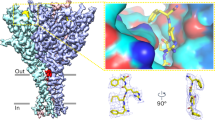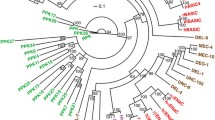Abstract
FMRFamide-gated Na+ channel (FaNaC) is the only known peptide-gated ion channel, which belongs to the epithelial Na+ channel/degenerin (ENaC/DEG) family. We have cloned a putative FaNaC from the Aplysia kurodai CNS library using PCR, and examined its characteristics in Xenopus oocytes. A. kurodai FaNaC (AkFaNaC) comprised with 653 amino acids, and the sequence predicts two putative membrane domains and a large extracellular domain as in other members of the ENaC/DEG family. In oocytes expressing AkFaNaC, FMRFamide evoked amiloride-sensitive Na+ current. Different from the known FaNaCs (Helix and Helisoma FaNaCs), AkFaNaC was blocked by external Ca2+ but not by Mg2+. Also, desensitization of the current was enhanced by Mg2+ but not by Ca2+. The FMRFamide-gated current was depressed in both low and high pH. These results indicate that AkFaNaC is an FaNaC of Aplysia, and that the channel has Aplysia specific functional domains.









Similar content being viewed by others
References
Adams CM, Snyder PM, WelshMJ (1999) Paradoxical stimulation of a DEG/ENaC channel by amiloride. J Biol Chem 274:15500–15504
Belkin KJ, Abrams TW (1993) FMRFamide produces biphasic modulation of the LFS motor neurons in the neural circuit of the siphon withdrawal reflex of Aplysia by activating Na+ and K+ currents. J Neurosci 13:5139–5152
Benos DJ, Stanton BA (1999) Functional domains within the degenerin/epithelial sodium channel (Deg/ENaC) superfamily of ion channels. J Physiol (Lond) 520:631–644
Coscoy S, de Weille JR, lingueglia E, Lazdunski M (1999) The pre-transmembrane 1 domain of acid-sensing ion channels participates in the ion pore. J Biol Chem 274:10129–10132
Coscoy S, Lingueglia E, Lazdunski M, Barbry P (1998) The Phe-Met-Arg-Phe-amide-activated sodium channel is a tetramer. J Biol Chem 273:8317–8322
Cottrell GA (1997) The first peptide-gated ion channel. J Exp Biol 200:2377–2386
Cottrell GA, Davis NW, Green KA (1984) Multiple actions of a molluscan cardioexcitatory neuropeptide and related peptides on identified Helix neurones. J Physiol (Lond) 356:315–333
Cottrell GA, Green KA, Davies NW (1990) The neuropeptide Phe-Met-Arg-Phe-NH2 (FMRFamide) can activate a ligand-gated ion channel in Helix neurones. Pflügers Arch 416:612–614
Cottrell GA, Jeziorski MC, Green KA (2001) Location of a ligand recognition site of FMRFamide-gated Na+ channel. FEBS Lett 489:71–74
Cropper EC, Brezina V, Vilim FS, Harish O, Price DA, Rosen S, Kupfermann I, Weiss KR (1994) FRF peptides in the arc neuromuscular system of Aplysia: Purification and physiological actions. J Neurophysiol 72:2181–2195
Ebberink RH, Price DA, Loenhout H, Doble KE, Riehm JP, Geraerts WP, Greenberg MJ (1987) The brain of Lymnaea contains a family of FMRFamide-like peptides. Peptides 8:515–522
Fujisawa Y, Ikeda T, Nomoto K, Yasuda-Kamatani Y, Kenny PTM, Muneoka Y (1992) The FMRFamide-related decapeptide of Mytilus contains a d-amino acid residue. Comp Biochem Physiol 102C:91–95
Green KA, Cottrell GA (2002) Activity modes and modulation of the peptide-gated Na+ channel of Helix neurones. Pflügers Arch 443:813–821
Green KA, Falconer SWP, Cottrell GA (1994) The neuropeptide Phe-Met-Arg-Phe-NH2 (FMRFamide) directly gates two ion channels in an identified Helix neurone. Pflügers Arch 428:232–240
Hille B (2001) Ionic channels of excitable membranes, 3rd edn. Sinauer Associates Inc, Sunderland
Immke DC, McCleskey EW (2003) Protons open acid-sensing ion channels by catalyzing relief of Ca2+ blockade. Neuron 37:75–84
Ishikawa T, Jiang C, Stutts MJ, Marunaka Y, Rotin D (2003) Regulation of the epithelial Na+ channel by cytosolic ATP. J Biol Chem 278:38276–38286
Ismailov II, Kieber-Emmons T, Lin C, Berdiev BK, Shlyonsky VG, Patton HK, Fuller CM, Worrell R, Zuckerman JB, Sun W, Eaton DC, Benos DJ, Kleyman TR (1997) Identification of an amiloride binding domain within the α-subunit of the epithelial Na+ channel. J Biol Chem 272:21075–21083
Jeziorski MC, Green KA, Sommerville J, Cottrell GA (2000) Cloning and expression of a FMRFamide-gated Na+ channel from Helisoma trivolvis and comparison with the native neuronal channel. J Physiol (Lond) 526:13–25
Kellenberger S, Hoffmann-Pochon N, Gautschi I, Schneeberger E, and Schild L (1999) On the molecular basis of ion permeation in the epithelial Na+ channel. J Gen Physiol 114:13–30
Kellenberger S, Schild L (2002) Epithelial sodium channel/degenerin family of ion channels; A variety of functions for shared structure. Physiol Rev 82:735–767
Lingueglia E, Champigny G, Lazdunski M, Barbry P (1995) Cloning of the amiloride sensitive FMRFamide peptide-gated sodium channel. Nature 378:730–733
McNicholas CM, Canessa CM (1997) Diversity of channels generated by different combinations of epithelial sodium channel subunits. J Gen Physiol 109:681–692
Palmer LG (1984) Voltage-dependent block by amiloride and other monovalent cations of apical Na channels in the toad urinary bladder. J Memb Biol 80:153–165
Paukert M, Babini E, Pusch M, Gründer S (2004) Identification of the Ca2+ blocking site of acid-sensing ion channel (ASIC) 1: Implications for channel gating. J Gen Physiol 124:383–394
Perry SJ, Straub WA, Schofield MG, Burke JF, Benjamin PR (2001) Neuronal expressoin of an FMRFamide-gated Na+ channel and its modulation by acid pH. J Neurosci 21:5559–5567
Pfaffinger PJ, Furukawa Y, Zhao B, Dugan D, Kandel ER (1991) Cloning and expression of an Aplysia K+ channel and comparison with native Aplysia K+ currents. J Neurosci 11:918–927
Poet M, Tauc M, Lingueglia E, Cance P, Poujeol P, Lazdunski M, Counillon L (2001) Exploration of the pore structure of a peptide-gated Na+ channel. EMBO J 20:5595–5602
Price DA, Lesser W, Lee TD, Doble KE, Greenberg MJ (1990) Seven FMRFamide-related and two SCP-related cardioactive peptides from Helix. J Exp Biol 154:421–437
Prosser CL (1973) Comparative animal physiology, 3rd edn. Saunders, Philadelphia
Rice P, Longden I, Bleasby A (2000) EMBOSS: the European molecular biology open software suite. Trends Genet 416:612–614
Ruben P, Johnson JW, Thompson S (1986) Analysis of FMRF-amide effects on Aplysia bursting neurons. J Neurosci 6:252–259
Schild L, Schneeberger E, Gautschi I, Firsov D (1997) Identification of amino acid residues in the α, β, γ subunits of the epithelial sodium channel (ENaC) involved in amiloride block and ion permeation. J Gen Physiol 109:15–26
Segal A, Awayda MS, Eggermont J, Driessche WV, Weber WM (2002) Influence of voltage and extracellular Na+ on amiloride block and transport kinetics of rat epithelial Na+ channel expressed in Xenopus oocytes. Pflügers Arch 443:882–891
Sheng S, Li J, McNulty KA, Kieber-Emmons T, Kleyman TR (2001) Epithelial sodium channel pore region: structure and role in gating. J Biol Chem 276:1326–1334
Shimizu Y, Kubo T, Furukawa Y (2002) Cumulative inactivation and the pore domain in the Kv1 channels. Pflügers Arch 443:720–730
Thompson JD, Higgins DG, Gibson TJ (1994) CLUSTAL W: improving the sensitivity of progressive multiple sequence alignment through sequence weighting, position-specific gap penalties and weight matrix choice. Nucleic Acids Res 22:4673–4680
Waldmann R, Champigny G, Lazdunski M (1995) Functional degenerin-containing chimeras identify residues essential for amiloride-sensitive Na+ channel function. J Biol Chem 270:11735–11737
Weber WM (1999) Ion currents of Xenopus laevis oocytes: state of the art. Biochim Biophys Acta 1421:213–233
Woodhull AM (1973) Ionic blockage of sodium channels in nerve. J Gen Physiol 61:687–708
Zhainazarov AB, Cottrell GA (1998) Single-channel currents of a peptide-gated sodium channel expressed in Xenopus oocytes. J Physiol (Lond) 513:19–31
Acknowledgments
We thank Dr. T. Snutch for providing pSD64TR, and Dr. Y. Fujisawa for sample of peptides.
Author information
Authors and Affiliations
Corresponding author
Rights and permissions
About this article
Cite this article
Furukawa, Y., Miyawaki, Y. & Abe, G. Molecular cloning and functional characterization of the Aplysia FMRFamide-gated Na+ channel. Pflugers Arch - Eur J Physiol 451, 646–656 (2006). https://doi.org/10.1007/s00424-005-1498-z
Received:
Revised:
Accepted:
Published:
Issue Date:
DOI: https://doi.org/10.1007/s00424-005-1498-z




